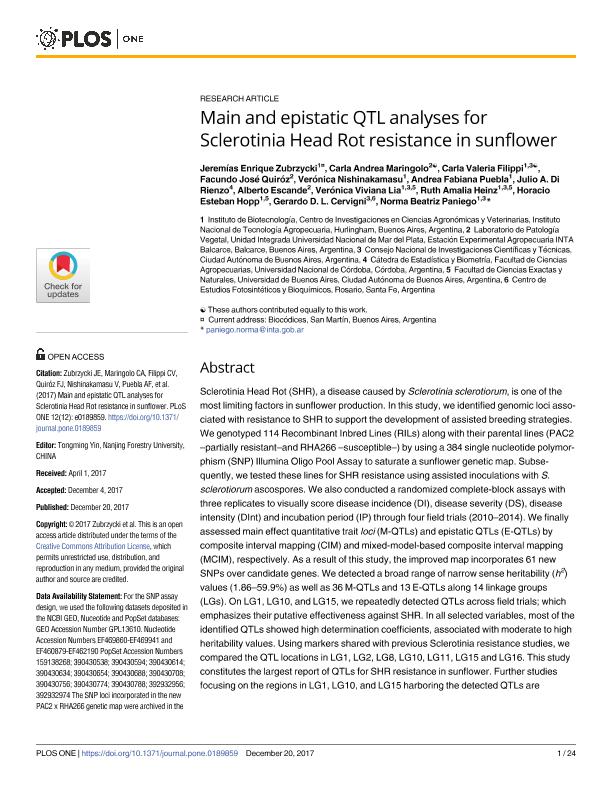Artículo
Main and epistatic QTL analyses for Sclerotinia Head Rot resistance in sunflower
Zubrzycki, Jeremías Enrique ; Maringolo, Carla Andrea; Filippi, Carla Valeria
; Maringolo, Carla Andrea; Filippi, Carla Valeria ; Quiroz, Facundo José; Nishinakamasu, Verónica; Puebla, Andrea Fabiana; Di Rienzo, Julio Alejandro; Escande, Alberto Raul; Lia, Verónica Viviana
; Quiroz, Facundo José; Nishinakamasu, Verónica; Puebla, Andrea Fabiana; Di Rienzo, Julio Alejandro; Escande, Alberto Raul; Lia, Verónica Viviana ; Heinz, Ruth Amelia
; Heinz, Ruth Amelia ; Hopp, Horacio Esteban; Cervigni, Gerardo Domingo Lucio
; Hopp, Horacio Esteban; Cervigni, Gerardo Domingo Lucio ; Paniego, Norma Beatriz
; Paniego, Norma Beatriz
 ; Maringolo, Carla Andrea; Filippi, Carla Valeria
; Maringolo, Carla Andrea; Filippi, Carla Valeria ; Quiroz, Facundo José; Nishinakamasu, Verónica; Puebla, Andrea Fabiana; Di Rienzo, Julio Alejandro; Escande, Alberto Raul; Lia, Verónica Viviana
; Quiroz, Facundo José; Nishinakamasu, Verónica; Puebla, Andrea Fabiana; Di Rienzo, Julio Alejandro; Escande, Alberto Raul; Lia, Verónica Viviana ; Heinz, Ruth Amelia
; Heinz, Ruth Amelia ; Hopp, Horacio Esteban; Cervigni, Gerardo Domingo Lucio
; Hopp, Horacio Esteban; Cervigni, Gerardo Domingo Lucio ; Paniego, Norma Beatriz
; Paniego, Norma Beatriz
Fecha de publicación:
12/2017
Editorial:
Public Library of Science
Revista:
Plos One
ISSN:
1932-6203
Idioma:
Inglés
Tipo de recurso:
Artículo publicado
Clasificación temática:
Resumen
Sclerotinia Head Rot (SHR), a disease caused by Sclerotinia sclerotiorum, is one of the most limiting factors in sunflower production. In this study, we identified genomic loci associated with resistance to SHR to support the development of assisted breeding strategies. We genotyped 114 Recombinant Inbred Lines (RILs) along with their parental lines (PAC2 ?partially resistant?and RHA266 ?susceptible?) by using a 384 single nucleotide polymorphism (SNP) Illumina Oligo Pool Assay to saturate a sunflower genetic map. Subsequently, we tested these lines for SHR resistance using assisted inoculations with S. sclerotiorum ascospores. We also conducted a randomized complete-block assays with three replicates to visually score disease incidence (DI), disease severity (DS), disease intensity (DInt) and incubation period (IP) through four field trials (2010?2014). We finally assessed main effect quantitative trait loci (M-QTLs) and epistatic QTLs (E-QTLs) by composite interval mapping (CIM) and mixed-model-based composite interval mapping (MCIM), respectively. As a result of this study, the improved map incorporates 61 new SNPs over candidate genes. We detected a broad range of narrow sense heritability (h2) values (1.86?59.9%) as well as 36 M-QTLs and 13 E-QTLs along 14 linkage groups (LGs). On LG1, LG10, and LG15, we repeatedly detected QTLs across field trials; which emphasizes their putative effectiveness against SHR. In all selected variables, most of the identified QTLs showed high determination coefficients, associated with moderate to high heritability values. Using markers shared with previous Sclerotinia resistance studies, we compared the QTL locations in LG1, LG2, LG8, LG10, LG11, LG15 and LG16. This study constitutes the largest report of QTLs for SHR resistance in sunflower. Further studies focusing on the regions in LG1, LG10, and LG15 harboring the detected QTLs are necessary to identify causal alleles and contribute to unraveling the complex genetic basis governing the resistance.
Archivos asociados
Licencia
Identificadores
Colecciones
Articulos(CEFOBI)
Articulos de CENTRO DE EST.FOTOSINTETICOS Y BIOQUIMICOS (I)
Articulos de CENTRO DE EST.FOTOSINTETICOS Y BIOQUIMICOS (I)
Articulos(SEDE CENTRAL)
Articulos de SEDE CENTRAL
Articulos de SEDE CENTRAL
Citación
Zubrzycki, Jeremías Enrique; Maringolo, Carla Andrea; Filippi, Carla Valeria; Quiroz, Facundo José; Nishinakamasu, Verónica; et al.; Main and epistatic QTL analyses for Sclerotinia Head Rot resistance in sunflower; Public Library of Science; Plos One; 12; 12; 12-2017
Compartir
Altmétricas



